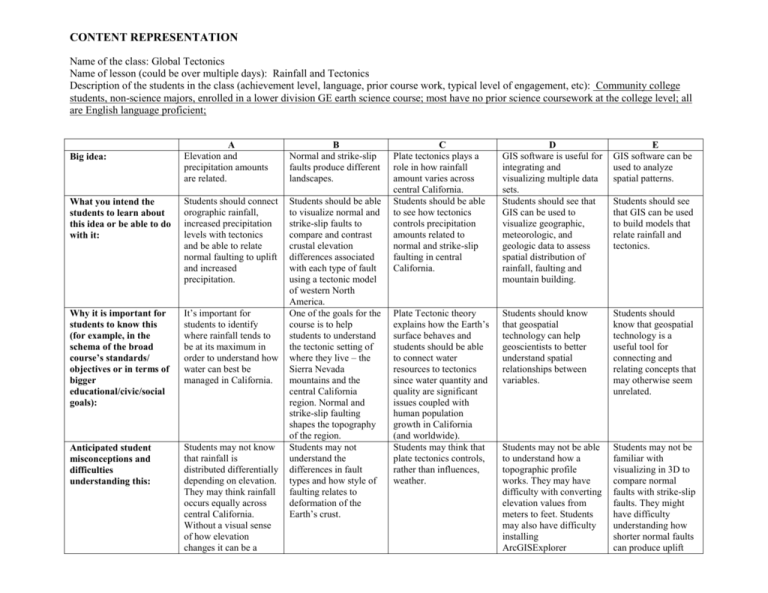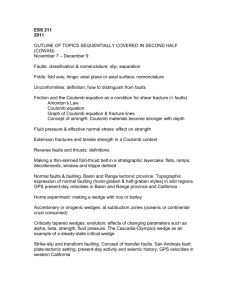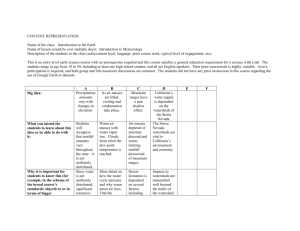CONTENT REPRESENTATION (CoRe) FORM FOR STORE
advertisement

CONTENT REPRESENTATION Name of the class: Global Tectonics Name of lesson (could be over multiple days): Rainfall and Tectonics Description of the students in the class (achievement level, language, prior course work, typical level of engagement, etc): Community college students, non-science majors, enrolled in a lower division GE earth science course; most have no prior science coursework at the college level; all are English language proficient; A Elevation and precipitation amounts are related. B Normal and strike-slip faults produce different landscapes. What you intend the students to learn about this idea or be able to do with it: Students should connect orographic rainfall, increased precipitation levels with tectonics and be able to relate normal faulting to uplift and increased precipitation. Why it is important for students to know this (for example, in the schema of the broad course’s standards/ objectives or in terms of bigger educational/civic/social goals): It’s important for students to identify where rainfall tends to be at its maximum in order to understand how water can best be managed in California. Anticipated student misconceptions and difficulties understanding this: Students may not know that rainfall is distributed differentially depending on elevation. They may think rainfall occurs equally across central California. Without a visual sense of how elevation changes it can be a Students should be able to visualize normal and strike-slip faults to compare and contrast crustal elevation differences associated with each type of fault using a tectonic model of western North America. One of the goals for the course is to help students to understand the tectonic setting of where they live – the Sierra Nevada mountains and the central California region. Normal and strike-slip faulting shapes the topography of the region. Students may not understand the differences in fault types and how style of faulting relates to deformation of the Earth’s crust. Big idea: C Plate tectonics plays a role in how rainfall amount varies across central California. Students should be able to see how tectonics controls precipitation amounts related to normal and strike-slip faulting in central California. D GIS software is useful for integrating and visualizing multiple data sets. Students should see that GIS can be used to visualize geographic, meteorologic, and geologic data to assess spatial distribution of rainfall, faulting and mountain building. E GIS software can be used to analyze spatial patterns. Plate Tectonic theory explains how the Earth’s surface behaves and students should be able to connect water resources to tectonics since water quantity and quality are significant issues coupled with human population growth in California (and worldwide). Students may think that plate tectonics controls, rather than influences, weather. Students should know that geospatial technology can help geoscientists to better understand spatial relationships between variables. Students should know that geospatial technology is a useful tool for connecting and relating concepts that may otherwise seem unrelated. Students may not be able to understand how a topographic profile works. They may have difficulty with converting elevation values from meters to feet. Students may also have difficulty installing ArcGISExplorer Students may not be familiar with visualizing in 3D to compare normal faults with strike-slip faults. They might have difficulty understanding how shorter normal faults can produce uplift Students should see that GIS can be used to build models that relate rainfall and tectonics. difficult concept to attain. Geospatial software can help. Teaching procedures (and reasons why): 1. Students will be introduced to online GIS technology using ArcGIS.com to make a map (1 half of a class session, ~45 minutes). This will give students some familiarity with the technology before the next class’ 2. Students will install ArcGISExplorer (desktop version), then open the lesson file (MS Word) and work through the lesson (~90 minutes ). 1. Images of a crosssection of the western U.S. with normal and strike-slip faulting will be provided to help students visualize a general tectonic model of the region. 2. Students will compare and contrast the two types of faulting to identify the different styles of crustal deformation. 1. Students will be asked to overlay 2 shapefiles (1of known normal faults and 1 of known strike-slip faults in central California) onto the basemap of the study area in order to add tectonic data to their model. 2. They will be asked to visualize the relationship between elevation, faulting, and precipitation using the 3D tool to assess the relationships between the different variables. Formative assessment: Specific ways of ascertaining students’ understanding or confusion around this idea (include likely range of responses): Before the lesson students will be verbally queried about the causes and effects of rainfall distribution in California to get a general assessment of their understanding. I expect students will say most rain falls in northern California, not in southern California. I don’t expect students will understand why rainfall generally increases with elevation, nor do I expect students to I haven’t had time to introduce information on specific types of faulting, so I don’t expect students to know anything about normal versus strike-slip faulting. The concepts will be briefly introduced during the lesson. Students have been introduced to the concepts of tension, compression, and transform motion along plate boundaries, however, so they should have a general The course has focused on plate tectonic theory and there have been no concepts introduced related to meteorology, weather, or climate, so I don’t expect there to be any depth of understanding of rainfall patterns. software. They may also have trouble following the step-by-step instructions during the lesson. 1. Students will be asked to install ArcGISExplorer Desktop software in order to understand that free geospatial software exists that can be used as a tool to build geospatial models of the earth and its systems. 2. Students will then open the program and work through the lesson provided as an MS Word file in order to gain geospatial skills. 3. I will have students work on their own laptop, but ask all of the students at their table for help first, before asking me for help, to help maximize my supportive efforts minimize the frustration levels. Maps, imagery, and diagrams have been used during the semester to teach some content, so students should be familiar at a basic level of mapping concepts (i.e. north is up, scale bars are used to show scale, etc.). Once they have used ArcGIS.com I expect that they will be more familiar with what a GIS is at a very basic level, which will help them with the STORE lesson in ArcGISExplorer. I expect there will be some along the eastern Sierra if they’re not connected together in one long, linear fault. 1. Students will use the software tools installed onto the computers to build 2D and 3D geospatial models. 2. They will perform an overlay analysis combining elevation, topography, precipitation, terrain, and tectonic, data. 3. They will then build a visual and conceptual model relating the variables in order to comprehend how tectonics shapes the Earth and helps determine rainfall and precipitation patterns. I have asked the class during the semester what they know about geospatial/GIS technology and none of the students in the class have had any formal GIS experience. I don’t expect them to know what spatial or overlay analyses are. I expect many have used Google Earth or seen it used (I have used it in class 2 or 3 times during the semester). But I don’t connect precipitation distribution with normal faulting and tectonics. understanding of the types of motions expected along plate boundaries. technology kinks along the way. expect them to know what a query is or that spatial queries can even be performed.





